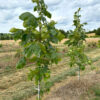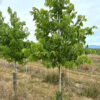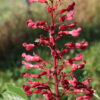
Quercus palustris, the pin oak, is a medium to occasionally large deciduous tree, usually growing 50 to 70 ft tall in the wild; sometimes reaching 100 ft under ideal conditions. Its native range extends from southern New England south to Georgia and west to Kansas and Iowa. In its native range, pin oak is typically a sub-climax forest tree occupying a number of habitats in association with sweetgum (Liquidambar styraciflua), tupelo (Nyssa sylvatica), American elm (Ulmus americana), and red maple (Acer rubrum). As its Latin name implies (from palus, swamp), Q. palustris is fond of soils that are damp in the winter, but is often found in much drier situations. Despite the species’ preference for damp winter soils, it is very unhappy with wet roots during the growing season; in this regard it is best

suited for well-drained areas in the landscape. In its growing habit, Quercus palustris presents a branching pattern unique amongst native trees: lower branches angled downward, middle branches level and topmost branches upswept, leading to a narrowly oval or pyramidal outline. It is among the narrowest of native oaks in crown spread at maturity.
As a landscape tree, Q. palustris normally grows no taller than 50-60 feet with a 30-foot spread. The 5” long-glossy, deep-green leaves are deeply-lobed with U-shaped sinuses (versus shallower C-shaped sinuses in the similar but more massive scarlet oak, Q. coccinea) and bristly tips. The foliage unfurls in spring with a pinkish-grey color and turns russet to bright red in autumn. Inconspicuous yellow-green flowers in spring are followed by small acorns which mature in the second autumn of growth. The bark is brownish-grey, smooth on young

trees, gradually becoming shallowly furrowed with age. The regular, almost formal, appearance of a mature pin oak makes it a very popular choice as a street tree, especially along broad boulevards and entranceways. The narrow habit and small acorn size, however, also make it one of the best oaks for the landscape in general. As noted above, pin oak prefers a moist but well-drained soil. It is easily transplanted due to its fibrous root system and lack of a taproot. It is also relatively unaffected by pests or disease, but is very intolerant of shade and of alkaline soils; alkalinity will cause severe chlorosis of the foliage and lead to a quick death.

The wood of Q. palustris is heavy and dense, but somewhat weaker than most oaks due to the knotholes from numerous branches. It is most commonly used commercially to make wooden pins (hence the common name). The leaves of pin oak are a preferred feeding species for several native moths. The small acorns are also a favorite of many birds, including wood ducks, mallards, wild turkeys, nuthatches, jays, and titmice due to their small size. Native Americans used tea made from the twigs and inner back as a remedy for digestive complaints.
White House Natives supplies Quercus palustris from 2”to 3” caliper. If you’re looking for a great-looking street tree or a smaller oak for the landscape, pin oak is worthy of your consideration.





